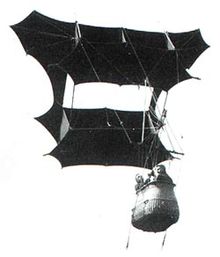Cody Warkite
The Cody Warkite aircraft was a war observation system and arose from Samuel Franklin Cody's experiments with kites . It was based on Lawrence Hargrave's boxkite ( box kite ), its further development later became known under several names: mankite , warkite or manlifter .
In the early days of manned aviation , experiments with kites carrying people were also undertaken in parallel to the well-known aircraft designs. One of the most successful and well-known systems was the "Cody Manlifting System" consisting of a series of kites. The importance of such a system was lost very quickly with the success of the aircraft pioneers, as the aircraft were more agile and versatile than kite systems.
The war observation system presented here attained its greatest importance in the years between 1901 and 1912, when it was being tested and used by the British Navy .
Mobile scouting post
The aim of the experiments was to build a kite that was suitable to lift a person into the air, ultimately so that a scout could overlook battlefields. Until then, the military had launched a tethered balloon for this purpose, but balloons had the disadvantage that they were only suitable up to a certain wind speed, after which they could no longer rise and land in a controlled manner.
Extension by wings and top sail
Cody found out that the box kite expanded by wings had much better lift and more good-natured flight characteristics, since the V-position of the wings stabilizes the aircraft itself. This principle is still used today in aircraft construction. In later versions of the kite he also got a top sail. Cody patented the version with the top sail.
Manlifting
The Cody Manlifting System essentially consisted of a kite chain (also called a dragon train) and a lifter kite.
The process of manlifting was first to let a pilot kite mount on a long line . The task of this kite was to keep the line stable for the following chain kites.
Conical stops with increasing diameters from bottom to top were placed in the line. The individual chain kites had a ring on the scales that matched one of the cones in diameter .
The individual chain kites were now hooked into the line on the ground and climbed up the line until they reached the cone that matched their ring. On this they got caught and stretched the line further. Cody himself wrote that he kept kites on the line until the line could carry the weight of 2 people without giving way.
This method also enabled the system to be launched from the ship . From land tests it is also reported that Cody set up the system on the ground and started it all at once.
The "lifter" was then hooked into the taut line. He pulled a trolley over the line to which the basket for the passenger / observer was attached. The angle of attack of the kite could be changed by the pilot from the basket using a cable system. This enabled the pilot to regulate his ascent and descent himself.
Other uses
In addition to being used as a lifter, the Cody kites found other uses as well.
Cody himself let himself be pulled across the English Channel twice (once successfully) by his kite in a folding boat. Dirk Kortland examines the kite used for this on the basis of historical sources and comes to the conclusion that this kite was steerable in order to enable cruising before the wind.
In 1938 attempts were made by the British Navy to use Cody's kites as a barricade kite against aircraft.




